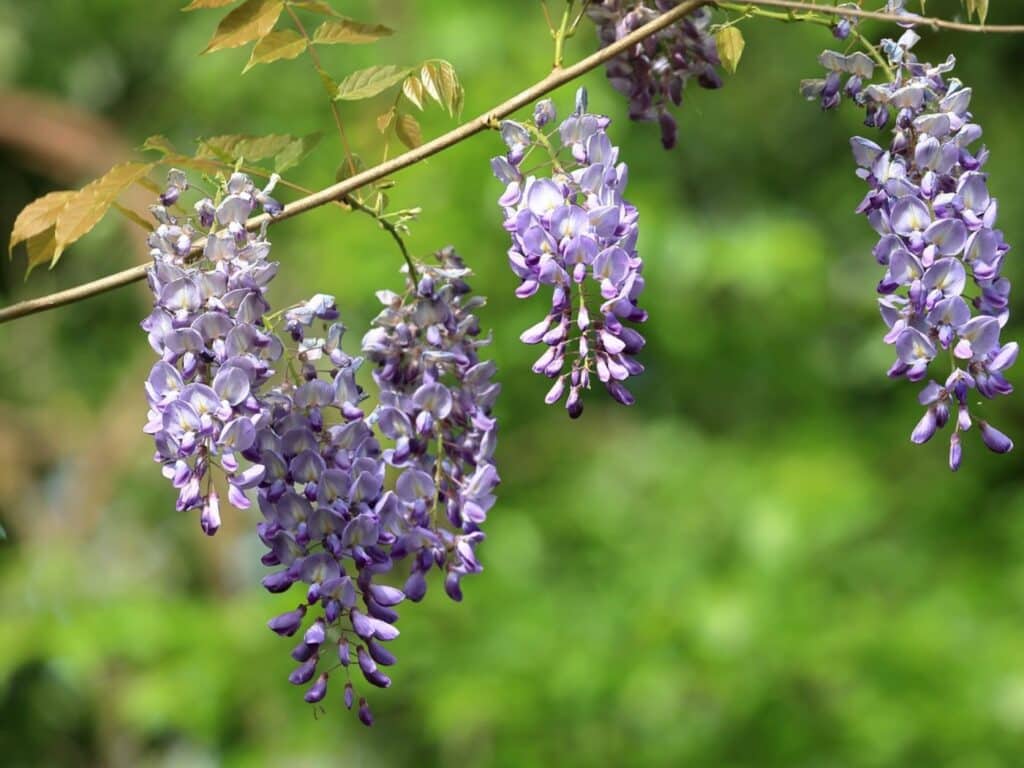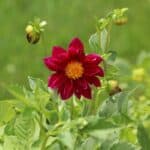Wisteria flowers (Wisteria), also known as Chinese wisteria, is a member of the pea family and an ideal floral species to add to your garden if you love lots of whimsical purple, pink, or white blooms. This beautiful flowering plant has many different garden uses. They can look fantastic if they are trellised to form a living wall. They are functional as a privacy screen and can help create charming arbors or pergolas. Many also love to use these romantic flowers to create attractive bonsai trees.
Wisterias can look striking all on their own. Still, they will look incredibly charming if you pair them with companion plants like clematis flowers, grape vines, roses, moonlight hydrangea, and sweet alyssum since these companions will add even more color and life to your garden.
In this guide, we are going to take a closer look at these companions, and we are going to discuss different ways to use them in your garden spaces.
What to Grow with Wisteria
If you want to give your wisteria plants and their companions the best chances of survival or if you want to create a beautiful garden that is easy to care for, then it is always best to combine plant species with similar growing requirements together. It is also best to pair wisteria with companions with a similar growing season that will complement the beautiful climbing plant.
Wisterias grow best if they are placed in well-drained soil with lots of fertilizer or organic matter. These flowers must also be planted in a full sun position or won’t produce enough blooms. In particularly hot regions, the flowers can be grown in a light-shade place, and it is best to water these thirsty flowering species every three days or they can wilt.
Here is a quick look at other plants that love sunlight, water, and well-drained soil.
Clematis
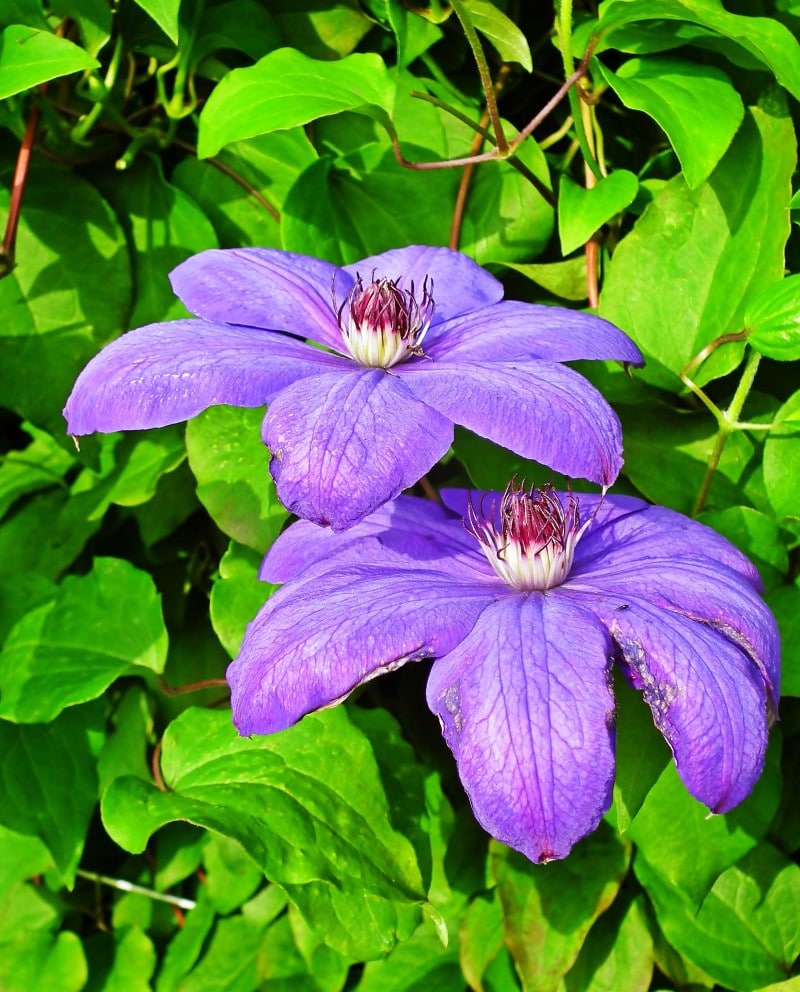
Clematis (Clematis) is an ideal companion plant for wisteria because it produces showy flowers. The vine plant can grow rather vigorously and come in many colors, like purple, blue, pink, white, red, and bi-colored flowers.
These perennials will grow alongside wisteria because they can handle soil rich in organic matter and drain well. They also need direct sunlight to produce many vivid flowers, but they are more drought-tolerant than wisterias.
For optimal results, planting these two species in separate containers is best so you can water wisteria more frequently. They can, however, grow very well in the same garden bed if planted directly in the soil.
Most varieties of clematis should look rather beautiful with wisteria because all of these flower colors will complement the purple, pink, or white wisteria blooms very well.
Grapes

Grapes (Vitis) are terrific wisteria companion plants because they blend nicely together since the hanging flowers of wisterias can look a little bit like grape bunches. Grapes can also be an incredible vine plant if you need to cover a large pergola or veranda.
Grape vines should be planted in full sun because they need lots of warmth to produce blooms and ripen fruits. These perennials should be planted in well-drained, loose soil and watered regularly to produce juicy fruits.
You can combine any variety of grapes with wisterias. However, most gardeners feel that red or dark purple grape varieties look better since they will stand out much more as they hang down from your trellis. Gardeners should, however, be careful to leave plenty of room for the grapes to expand because they need lots of air circulation. They are also quite vulnerable to ant infestations and must be checked regularly to ensure that pesky creatures won’t devour their root systems.
Roses
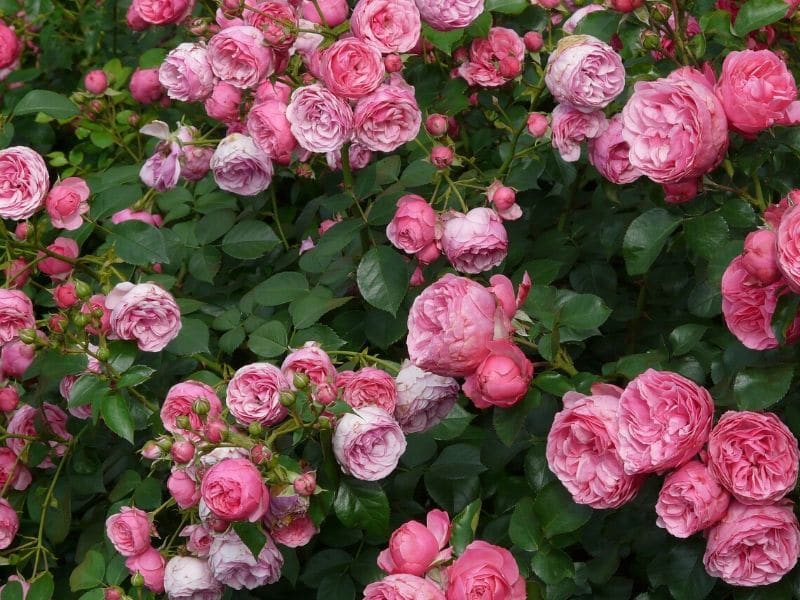
Roses (Rosa) can be excellent companion plants for your wisteria garden. You can choose ground-cover roses to plant around the base of your wisterias to fill out the garden and keep the soil cool and moist. Or you can select vine rose varieties to trail up alongside your wisterias to create a showy pergola or arbor.
As with wisteria, roses need full sun with well-drained soil rich in organic matter. These plants should also be watered regularly because they can quickly wilt and die if they become too dry.
There are over 320 species of rose, and they come in almost any color imaginable. If you want to add more contrast to your garden, you should pair purple wisteria with a striking rose variety like bright red or yellow. You can combine your wisteria with complementary rose colors for a more tranquil garden effect.
Moonlight Hydrangea
Moonlight hydrangeas (Hydrangea hydrangeoides ‘Moonlight’), also known as climbing hydrangea or Japanese hydrangea vine, can also be good companions because their large clusters of showy white flowers will add lots of interest to your garden. The plant’s shrub-like appearance will also add much texture to your garden.
These wisteria companions are versatile and can be grown in full sun and shade. However, they must be grown in moist, well-drained soil, so remember to water them regularly. Avoid wet sites or soggy soil because this can cause root rot for this beautiful flowering species.
Gardeners should know that moonlight hydrangeas are slow growers and can take up to seven years to mature and fully bloom. Because of their slow growth rate, it is essential to consider a desired position before planting them in the soil.
Alyssum
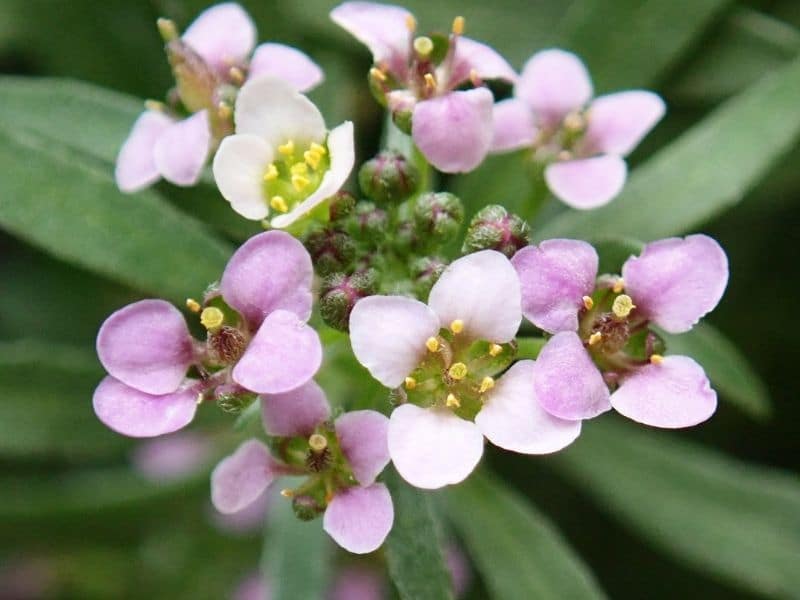
Alyssum (Lobularia maritima), also known as sweet alyssum or sweet alison, is a good companion if you are looking for a ground cover for your wisteria plants. Hundreds of different varieties of this low-profile plant come in all sorts of colors ranging from deep purple to peach tones. This ground cover will produce lots of blooms that can lighten up the areas around the base of your vine plants.
Sweet alyssum can be grown in full sun to partial shade. They can tolerate dry soils but will grow best if they are watered regularly. They should be planted in well-drained soil with plenty of compost, but don’t grow well in soil with a lot of nitrogen.
The perennials are usually treated as annuals and should be grown in front of your wisteria’s root system so they can keep the soil moist and so you can easily reach them to clear these annuals away when they die.
Related: Alyssum Companion Plants
What NOT to Grow with Wisteria
Wisterias can grow well with most vine plants and ground-covering species. But it is not good to plant them underneath a tall tree because they won’t get enough sunlight.
Since these plants love plenty of water, gardeners should avoid planting them with drought-tolerant plants like lavender, coneflowers, or black-eyed Susans. These hardy species can develop root problems if watered too often.
Landscaping Ideas for Wisteria and Companions
Vine plants have many different uses in your garden and wisterias certainly are flexible because they produce such showy flowers and lush vines. Here is a quick look at different ways to use wisteria and the companions we discussed in this guide in your garden.
Living Walls Or Screens
Wisterias and other companions like vine roses, moonlight hydrangea, grapes, and clematis are ideal for creating showy living garden walls or privacy screens in your garden. The vivid blooms will look rather striking if you trail the up along a picked or wired fence.
Pergolas Or Arbors
You can also grow your vine plants over an arbor or a pergola to create a striking garden feature or to create some shade for an outdoor breakfast nook. The dangling wisteria flowers will create a sense of movement around your garden structures while other flowering species like roses or hydrangeas can be used to complement their colors or fill out these structures for a more dense and vigorous effect.
Final Thoughts
Wisterias are terrific trailing plants to include in your garden to create a romantic effect. Combining them with other flowering plants like roses, moonlight hydrangeas, clematis, or grapes will look charming. You can pair them with low-profile plants like alyssum to keep their root systems cool and moist.
Our guide gave you some creative ideas for your wisteria garden to create a whimsical space you will love spending time in.
Learn more about Wisteria symbolism to see why people love this plant!

